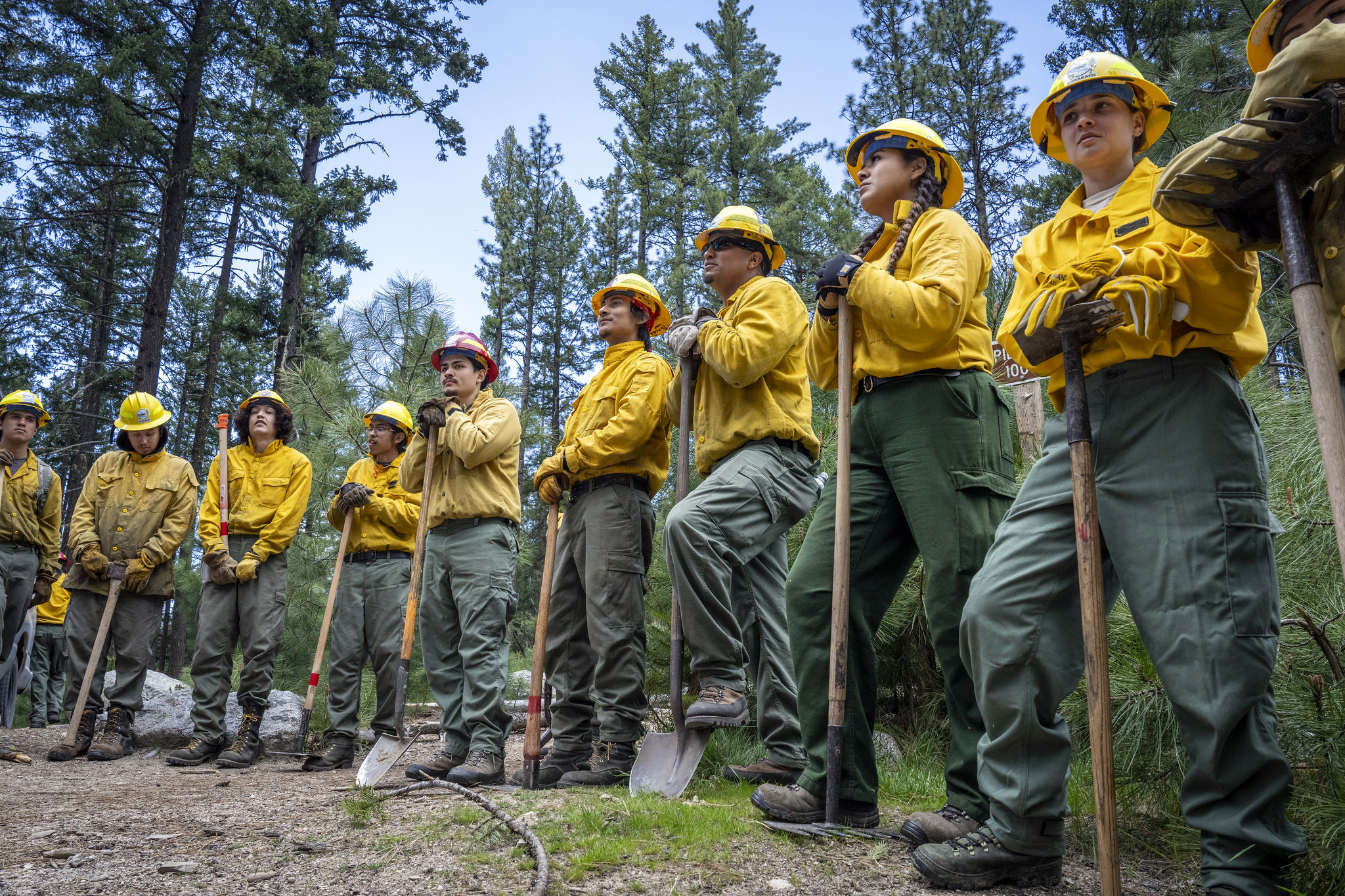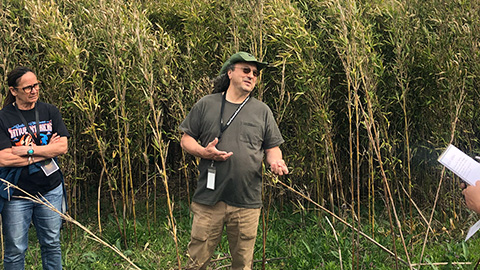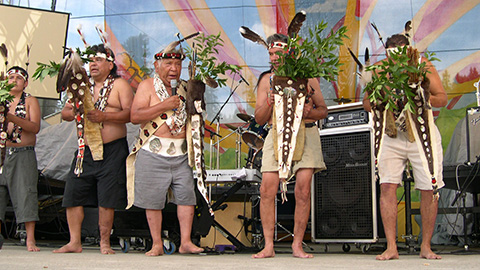
On a July Colorado mountain morning, 10 youth representing six Native American Tribes came together to form the 2022 Native American Environmental Awareness National Summer Youth Practicum cohort and embark on an educational adventure in natural resource management.
Their guide, Ashley Mueller is the education coordinator for the Native American Fish and Wildlife Society. She wanted to help them access the opportunities she had as a Native American youth. Mueller grew up on the Navajo Nation – the largest Indian reservation in the U.S. – graduated from Colorado State University, and researched rancher-jaguar interactions in Belize.
“I always had the need to share all these different programs to help students at home,” said Mueller. “In the summer youth practicum, we hope to engage youth and help them gain a better understanding of natural resource management with a heavy focus on traditional ecological knowledge, Tribal natural resources, and career fields within the natural resources profession.”

Since 1991, the youth practicum has served as an annual event that incorporates the cultural and historical aspects of natural resource management by inviting Tribal elders and professionals to share their experience and introduce native students to Tribal natural resource management and career opportunities available to them.
From July 9 to July 16, students engaged with 23 speakers, participated in workshops from field sketching to conservation law enforcement, built confidence on the Colorado State University Mountain campus ropes course, developed trust through team building exercises, learned fly fishing, and competed in a Tribal wildlife challenge.
Electrofishing Demonstration

In one of the workshops, students learned about fisheries management with U.S. Department of Agriculture’s Forest Service fisheries biologist Chris Carroll and fisheries technicians Aaron Altier and Cece Amato. Through hands-on experience with water and fish sampling and an electrofishing demonstration, students learned about Colorado fish ecology, aquatic ecosystems, and Forest Service careers.
“I remember, as the son of a forester, my first experience with a backpack electrofisher and was amazed and ultimately became a fisheries biologist,” said Carroll. “Sharing this with the kids is pretty dang cool because you can feel this atmosphere of wonder from the kids.”
Electrofisher backpacks put a small voltage of electricity in the water that safely stuns the fish long enough for the biologist to net and collect biometric data, such as length and weight, to assess how well the fish are thriving in their aquatic habitat. The electrofishing demonstration helped bring to life a real-world career path available to the students.
Carroll said the most common question from the students was, “How are we going to safely be in the water with electricity?” It was a fair question that served as a fun learning opportunity about electric conductivity and the insulative value of rubber wading pants.
“I think it's really huge when youth break that barrier and ask more questions,” said Mueller. “They get to be more engaged and start to learn how to use their voice and become more ready to share the voices that they already have, but in a loud and ever-changing way.”
Conservation Law Enforcement

Mueller recalled a student who was interested in becoming a police officer but felt conflicted because she also liked hiking and natural resources.
“And we're like, ‘Well, have you learned about conservation law enforcement?’” said Mueller. “And she was like, “What? What's that?’”
The student found out when her cohort investigated a simulated moose poaching incident. The students collected evidence at the crime scene, which led them to a suspicious vehicle and eventually the perpetrator. Experiences like the moose poacher exercise teach students about the importance of taking notes and being observant. The exercise also helped some students identify career paths for themselves.
“After that, she was like, ‘I'm going to be a conservation law enforcement officer with the Navajo Nation,’ because she's from the Navajo Nation,” said Mueller. “The youth practicum is about stuff like that – helping students be able to really connect their passions and interests that they have with their career goal.”
Native American Natural Resource Managers Needed

Native American youth involvement in conservation careers is important for Tribes and nation-wide conservation efforts. The 574 federally recognized Native American and Alaska Native Tribes cumulatively manage or influence nearly 140 million acres of land – a total area larger than California. These lands include 730,000 acres of water bodies, 10,000 miles of waterways, 18 million acres of forests, and habitat for over 500 threatened or endangered species. Tribally managed lands are pieces in broader interconnected ecosystems and landscapes that Native Americans stewarded for tens of thousands of years.
“For a lot of Tribes and Indigenous peoples, their ways of life and ways of knowing, their language, their songs, their culture, their dress, their traditional foods, and their survival is all connected to natural resources,” said Mueller. “It's important to have our knowledge systems be part of that conversation when we're talking about issues – like the fight against climate change and the fight against invasive species – because there's a lot of valuable knowledge that native Indigenous people have and can be shared.”
However, there is a shortage of native ecology and conservation professionals in Tribal communities and the natural resources professions.
“Compared to other ethnic groups, Native Americans and Alaska Natives have the lowest representation in natural resources,” said Mueller. “That's one big reason why it’s really important, reaching out to our youth about conservation land stewardship, because we can spark that interest and show them that there are some cool career fields and ways to get involved with conservation in their community.”
Tribes Continuing Land Stewardship
“There's actually a lot of cool work happening within Tribal communities that youth can participate in,” said Mueller.
She pointed to the Menominee Tribes working with black bears, the Colville Tribes working with lynx, the Standing Rock Tribe working with black footed ferrets, and the Penobscot Tribe’s work with fish passages as a few of many examples.
“In the practicum, we share all these cool projects that are happening and that Native professionals are working on,” said Mueller. “We show Native American youth that there are a lot of natural resource issues that need to be addressed with real career opportunities for them, even within their own communities.”
More Information
The youth practicum was hosted by the Native American Fish and Wildlife Society with financial and resource support from partners, including the USDA Forest Service, U.S. Bureau of Indian Affairs, Bass Pro Shops and Cabela’s Outdoor Fund, Orvis, and the Colorado State University Native American Cultural Center.
The Native American Fish and Wildlife Society Summer Youth Practicum is open to incoming 10th through 12th grade Native American students, who are encouraged to apply for future events at the Native American Fish and Wildlife Society website.
The Native American Fish and Wildlife Society is a national nonprofit Tribal organization founded in 1983 to assist Native American and Alaskan Native Tribes with the conservation, protection and enhancement of their fish, wildlife, habitat, and cultural resources.





